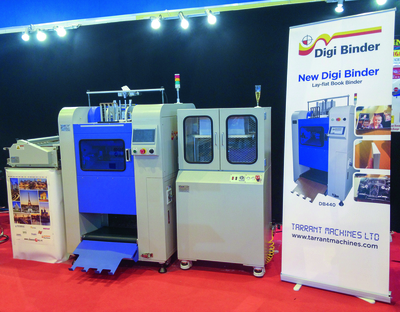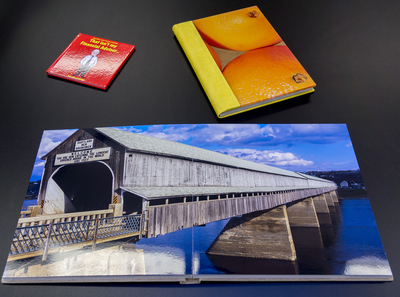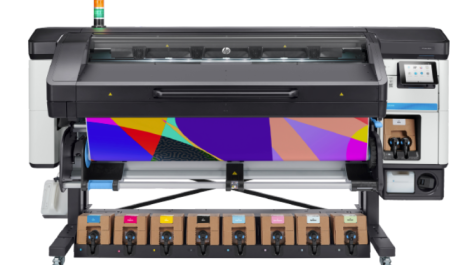Layflat books are an attractive way of presenting photographs but are increasingly being adopted for high value promotional print too. Simon Eccles surveys the production options.
One of the spinoffs from the development of digitally printed photo books in the past decade has been the emergence of a layflat binding method as an increasingly popular choice for high end, prestige work. Layflat books open completely flat across the centre fold without the usual gutter associated with a conventional spine. This means that photographs in particular can be run across both halves of the spread, interrupted by only a subtle fold line down the middle. This gives some exciting design options, including landscape formats that open to display panoramas.
There is more to it than photobooks, as Imaging Solutions explains on its website: layflat is ’eminently suitable for corporate publications, coffee table books, art books, or cookbooks – anywhere quality images and content are bound in books’. Creative agencies are using layflat for pitch books (which are often cost-no-object, an attractive idea for printers), and at least one luxury car maker is using layflat brochures.
Lewis Price, Ashgate’s product manager for the entry level Maping Fastbind range of layflat book kit, commented: ‘We’re selling well into the high value book market, such as property, automotive. These have actually been the biggest sellers in the past few years.’ Richard Tarrant, owner of Tarrant Machines, has found the same thing. Out of the five Kisun layflat binding systems he has supplied in the UK in the past year, four have been primarily for non-photo use, especially promotional books intended for the booming overseas markets in London property.
Construction of a layflat book is simple, but comparatively time consuming compared to more conventional binding methods. It starts with single-sided printed pages that are folded in half, then one blank side is glued to the opposing blank side of the next spread in the sequence, and so on until all the spreads are attached to form a block. The first and last pages are generally glued to a separately produced hard case or soft wraparound cover. The upshot is that there is no need for sections, edge gluing, sewing or wire stitching.
The requirement for simplex printing is a positive advantage for some types of digital press, where duplexing means a second printpass that halves the throughput. LumeJet’s interesting S200 ‘Photonic’ high res digital light printer exposes silver halide paper, which is almost always only light sensitive on one side.
Fujifilm’s B2 format inkjet Jet Press 720, which is touted for photo work, is simplex only, though you can print the other side by work and turn.
 A Kisun Digi Book DB440 block assembler (with the blue covers), shown by Tarrant Machinery at a recent exhibition.
A Kisun Digi Book DB440 block assembler (with the blue covers), shown by Tarrant Machinery at a recent exhibition.
Production methods
So if you want to get into layflat book production, what are your choices? Actually it is pretty well the same as last time we surveyed this market almost a year ago, but there’s been a bit of musical chairs among the distributers.
At the most basic, you just need a creaser/folder and double-sided adhesive film, lining up sheets in a simple jig you could knock from wooden strips, then making them flat with a hand press and guillotining everything neatly. Hard cases can be made up by hand, again with some sort of jig for accuracy and to aid in folding the cover sheet edges over the boards.
Most people would prefer something ready made, and for the past few years the first port of call has usually been Ashgate Automation, UK distributor of the Finnish Maping Fastbind system.
This centres on a book block assembly table called FotoMount, ranging in price from £1990 for the 304 x 304 mm all-manual F32, to £3990 for the 457 x 457 mm F46e with an electrically moved rising guide bar. Pages are attached by double-sided adhesive interleaved sheets.
You may also want the accompanying Casematic table, for making hard cases from greyboards and self-adhesive cover paper. Costs are modest: about £1495 for a Casematic up to 330 x 330 covers, or £3990 for 450 x 450 mm.
According to Mr Price, ‘a lot of people use our casemakers even if they put in one of the automatic book block makers. They don’t need so many cases.’
Motorised gluing systems
If you have got a regular requirement for higher volumes of layflat books, there is a choice of motorised book block assembler-gluers, automatic casemakers and casing-in machines.
However, whatever you choose there is a fairly big step up in price after the Maping systems. The past year saw Duplo International take on the UK agency for the Photobook
Technology layflat book makers, previously handled by IFS. The machines are made in Italy and Germany, though Photobook Technology’s head office is in Switzerland.
The book block assembler is called Mitamax, which runs at 70 cycles per minute on signatures up to 380 x 330 mm (folded).
An optional version can handle up to 380 x 450 mm, opening to a huge 900 mm. It uses cold glue and it is recommended that blocks are pressed before further processes. The company also makes complementary automated casemaking and casing-in machinery.
Encore Machinery sells the Italian Samed Innovazione range. Its automated layflat book block assembler is called Photofast. This can be supplied for cold gluing (for £43,000) or hotmelt (for £79,000) and can handle formats up to a huge 480 x 400 mm. Speed is up to 30 cycles (sheets) per minute. Complementing these is a range of casemaking machines in various automation levels, called Darix, for between four and 20 cases per minute, ranging from £28,000 to £95,000.
There are also the fully automatic Hektor I and II casemakers for longer runs, costing from £150,000 to £170,000 depending on options. Imaging Solutions of Switzerland has a complete automatic production line for layflat book blocks, though you can buy components separately too. These are high end systems, typically costing between £300,000 and £400,000. The block maker is called fastBlock and can be roll or sheet fed, handling cutting, creasing, folding, pressing, plus hotmelt gluing on the fastGlue unit. It can produce up to 170 blocks per hour, depending on size, thickness etc. Maximum size is 325 x 450 mm, with block thicknesses up to 30 mm.
A complete line adds fastCase, a hard cover case maker and casing-in system, and fastForm, that forms the hinge creases.
A separate system, fastBooklet, is intended for smaller format books and photographic paper, and again uses hotmelt adhesive.
Perfect Bindery Solutions in Oxfordshire is UK agent for the US On Demand Machinery range of automatic and semi-automatic book makers. These include the Sidewinder, specially developed to automate blocks made from Mohawk Panoramic pressure-sensitive adhesive papers. It scores, folds and presses up to 100 blocks per hour of up to 343 x 368 mm open and 685 x 368 mm closed (and up to 25 mm thick). This costs around £66,000.
ODM also offers assisted-manual casemaking lines. There are two sizes of Sticker semiautomatic casing-in machines, plus the Super Sticker fully automated casing-in machine to handle from 400 to 600 books per hour. ODM’s Smasher press is used to form joint hinges on the cases.
Tarrant Machines is UK distributor for the Kisun Digi Binder DB-440 layflat block assembler and has sold five in the UK in the past year, and another five in other countries via agencies. First seen at drupa 2012, DB-440 uses water-based glue and can also feed end boards and apply wraparound paper covers (the edges are folded over the boards separately afterwards). Maximum folded size is 360 x 380 mm and it can glue up to 60 folded sheets per minute. The price is about £57,000. The Digi Gluer for soft covers costs about £5000.
Kisun also makes casemaking and casing-in machines, but Richard Tarrant prefers to sell models from the CMC-Italia range, which he says are far better. The Q-Cover range includes various casemaking components with different levels of automation. The Q-Cover 2 casemaker is especially popular, according to Mr Tarrant, and costs about £32,000, while the Q-Case casing-in machine costs £20,000. The range also includes presses and French groove hinge formers.





